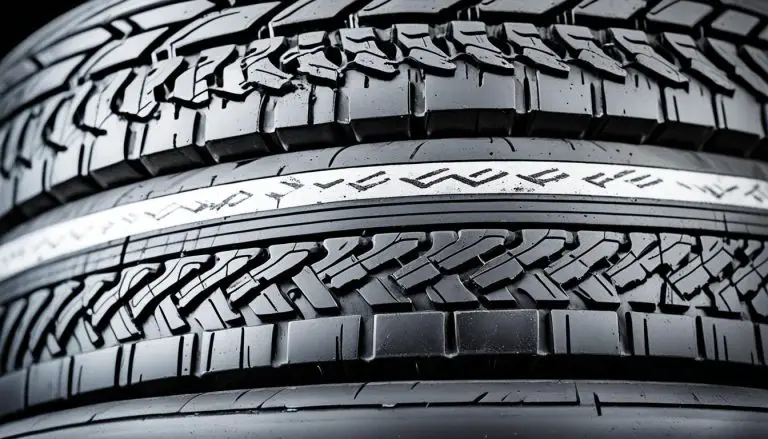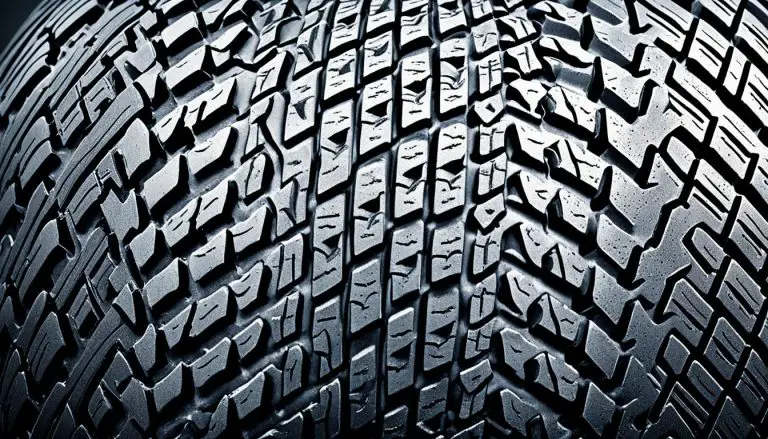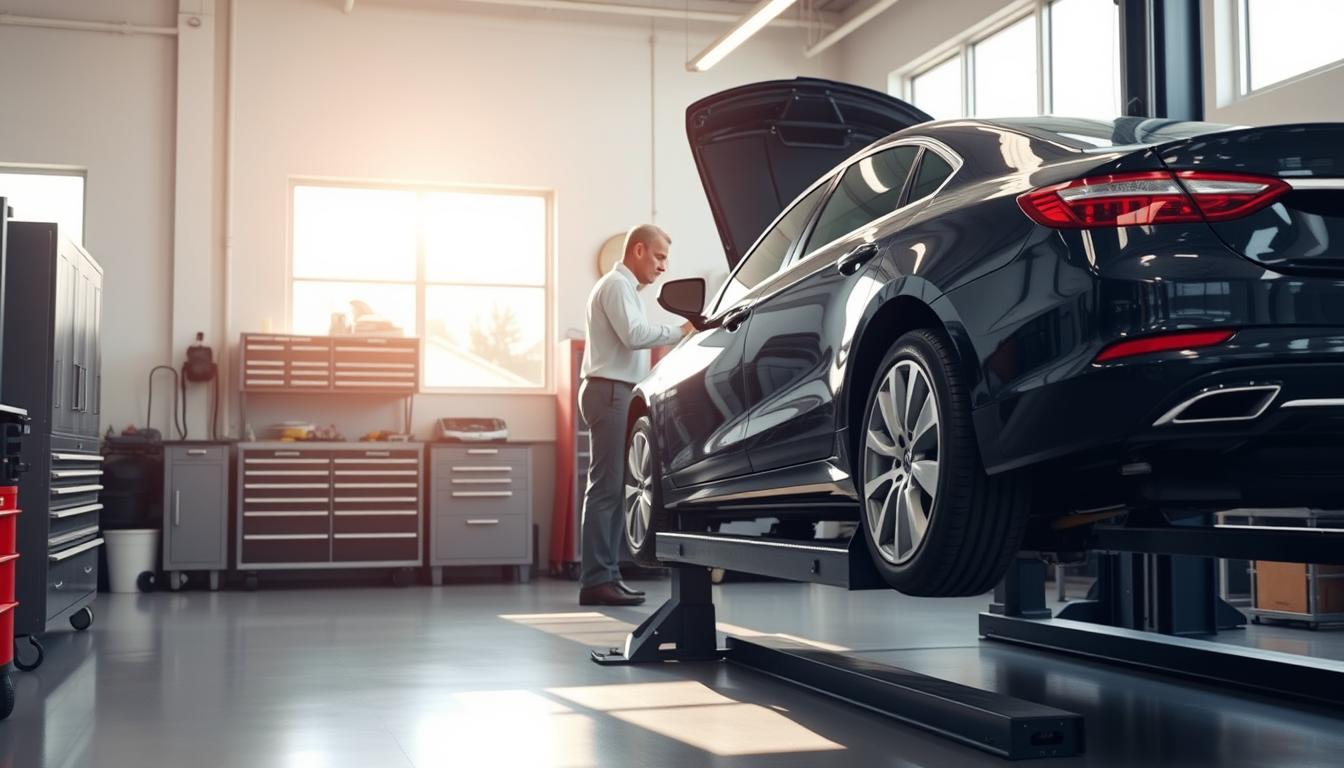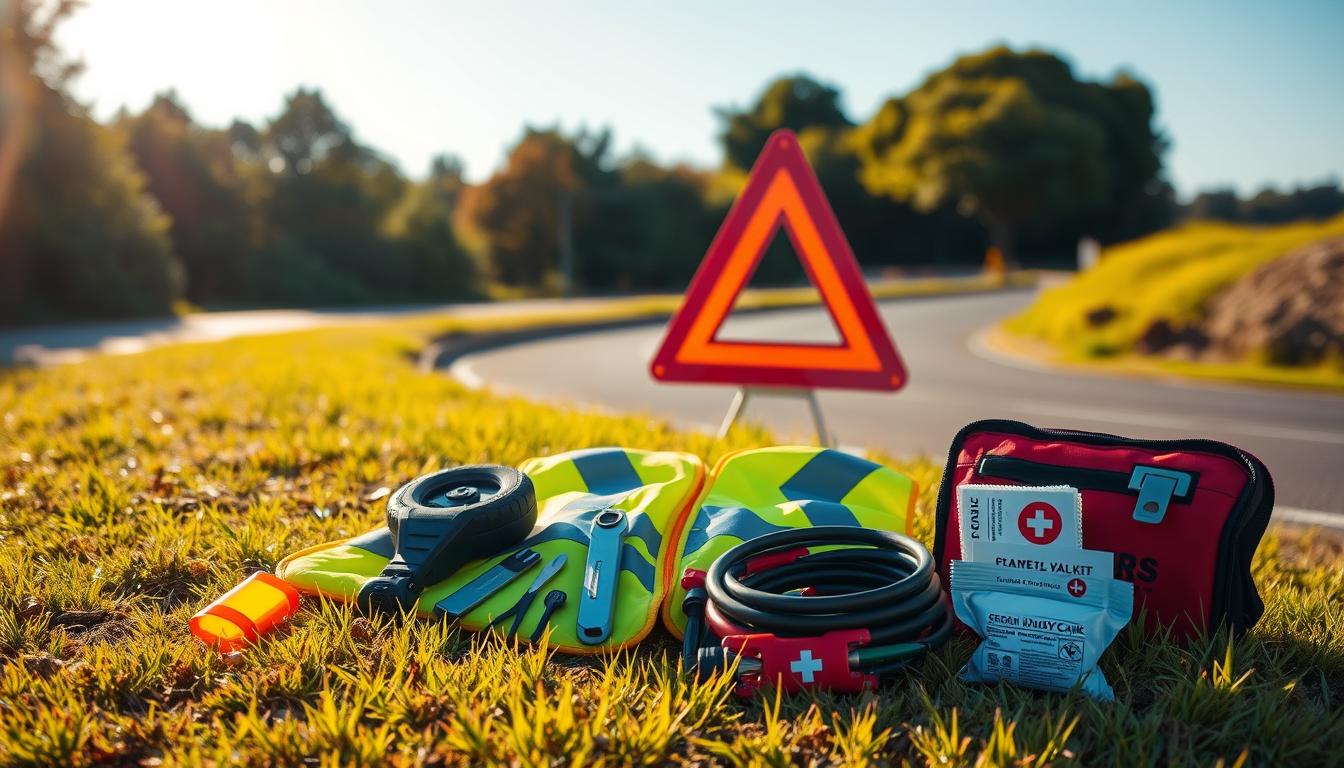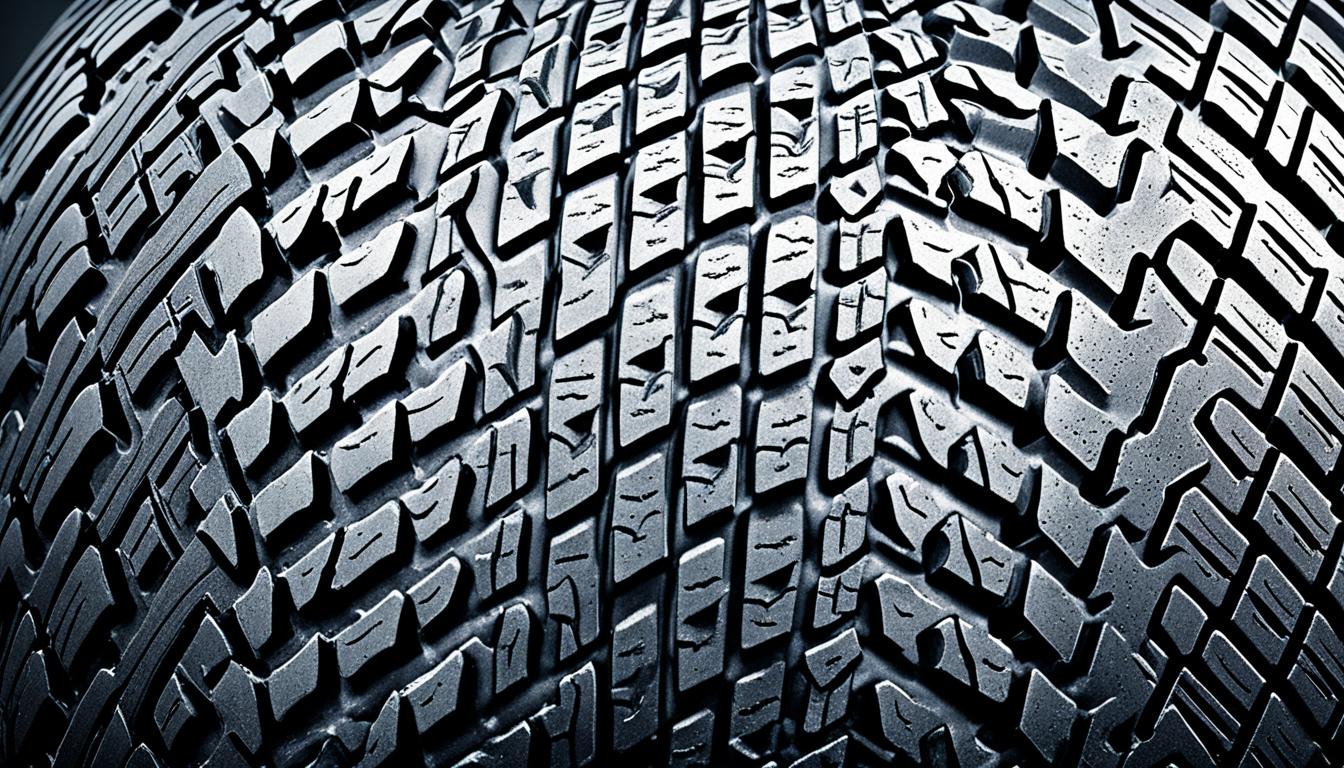
Brand-new tires can have a deep tread, measuring 10/32″ to 11/32″. But, tires that need replacing might have only 2/32″ left.1 Knowing about tire tread is key for safety and better driving. It’s about keeping your vehicle efficient and your tires lasting longer.
The tire tread is the depth from the top to the deepest groove on a tire. It’s important because it affects how well you can steer and stop. When the tread is worn, your tires can’t grip the road as well. This means you might slide or take longer to stop. Keeping a tread depth above 4/32″ is crucial for safety1
Our tire tread guide will cover key concepts of tire tread. We’ll talk about why it’s important, how to make tires last longer, and drive smarter. Get ready for tips that will keep your car safe and working well.
Key Takeaways
- New tires have tread depths ranging from 10/32″ to 11/32″, providing optimal road grip1.
- Tire tread above 4/32″ is generally recommended for safe driving1.
- Legal minimum tread depth is 2/32″; anything below is considered bald and unsafe1.
- Winter tires lose traction below 4/32″, making them unsuitable for icy conditions1.
- Understanding tire tread and maintaining proper depth can significantly enhance vehicle performance and safety.
What is Tire Tread?
Tire tread is the surface of a tire that touches the road. It’s made of rubber, carefully designed to grip the road well. This design makes sure you can drive safely and smoothly. Good tire tread is key to avoid accidents.
Importance of Tire Tread
The importance of tire tread is seen in how it helps the tire grip the road better. Tires with deep grooves push water out when it’s wet, stopping the tire from sliding on water. This keeps you safe by keeping your car steady, even on wet roads2.
Having the right tread depth is crucial for tire safety. The U.S. Department of Transportation says you should change tires when the tread gets as low as 2/32”. Not doing so can make your tires slide more and need longer to stop. This can put you at risk of an accident.
Tire Tread Functionality
What tire treads do is very important. They guide water away to prevent hydroplaning. Treads that are not symmetrical also mean better handling in both wet and dry weather3. Specific tires like snow or off-road ones are made for varied needs, making driving safer in different conditions.
Tires are designed for specific uses. For example, snow tires work best in cold weather and on icy roads because of their unique design. Off-road tires, on the other hand, have deeper patterns suitable for dirt and mud. The right tire choice improves safety and performance, especially when you match the tire to your driving conditions.
Choosing the right tire tread for your driving style and where you drive makes you safer. Make sure to check your tires often for wear and tear. Keeping your tires in good condition makes them last longer and perform better.
Understanding Tire Tread Depth
Tire tread depth is vital for your safety on the road. When new, tires in the U.S. usually have 10/32” or 11/32” of tread4. When the tread gets down to 2/32”, your tires start to lose grip and become less safe, according to the U.S. Department of Transportation4. Checking tread depth regularly is more than just a recommendation, it’s a wise safety step.
Measuring Tread Depth
Measuring tire tread depth accurately is crucial for staying safe. Tools like tread depth gauges show tread in 32nds of an inch and millimeters4. Features like wear bars at 2/32” on some tires make it simple to know when it’s time for new ones4. Checking your tread often helps prevent accidents and makes your tires last longer5.
Legal Requirements for Tread Depth
The U.S. law says passenger vehicle tires must have at least 2/32” of tread. Some states even enforce this with driving laws5. Although tires usually have wear bars at this level, it’s smart to check the tread for safety and to keep your tires in good shape5. For driving in snow or ice, winter tires need more tread to grip well, showing why checking regularly is important6. If your tires wear unevenly, it could mean there’s a problem like not enough air or your wheels are not straight. So, always check the whole tire for wear46.
How to Check Tire Tread Depth
Checking tire tread depth is key for safety and performance. You can use the penny, quarter, or a tread depth gauge.
Penny Test
The penny test is an easy way to know if your tires are safe. Simply stick a penny in the tire tread with Lincoln’s head down. If you see the top of his head, your tire tread is too low. This means it’s below 2/32″ and it’s not safe4. It’s a quick check that helps you stay on top of tire health.
Quarter Test
For a bit more accuracy, try the quarter test. Put a quarter into the tire tread with Washington’s head facing down. If you can see the top of his head, your tire has less than 4/32″ tread. This isn’t very safe for driving, so it’s time to change them for better road safety and performance4.
Tread Depth Gauge
If you want a very precise measurement, use a tread depth gauge. You can buy these at car parts shops. They show the tread in both 32nds and millimeters4. Just stick it into the tread and press down gently. This gives you the exact depth. It makes sure your tires are good legally and for the best driving experience.
Need more help? See the Bridgestone Tire website. They have detailed steps and extra tips for checking your tire treads.
Tire Tread Wear and Its Implications
It’s important to keep your tire tread in good shape for safety. As tires wear down, they become less safe and can cause accidents more easily.
Effects of Tread Wear on Safety
Worn out tire treads mean you can’t stop as quickly and your car might slip more on wet roads. Nearly all states in the US require your tires to have a depth of at least 2/32-inch7.When parts of the tread reach this level, it’s time for a new tire7. New tires usually start off between 9/32-inch and 11/32-inch deep7. Checking your tires regularly and keeping the tread in good condition is key to staying safe.
Common Causes of Tread Wear
Lots of things can wear down your tire treads. If you drive aggressively, like taking corners too fast or braking hard, your tires will wear out quicker. Bad tire pressure or alignment can also make tires wear unevenly7. Sports cars’ tires wear fast since they’re built for speed7. Regularly checking tire pressure and alignment helps prevent these issues.
The load index tells you how much weight a tire can bear, like 1,477 pounds for midsized car tires8. Most all-season and performance tires can go for 65,000 miles or more8. Tread wear indicators show us when tires need attention. If the tread wears unevenly, it’s probably time for maintenance or a new tire9.
Types of Tire Tread Patterns
It’s key to know about the different tire tread patterns. Understanding them can make our roads safer and improve how vehicles work. Symmetrical treads are top choices for cars and trucks. They cover a big part of the tire market because they are tough and good for every day driving10. These tread design variations boost stability and lower noise, perfect for regular driving.
For sports cars and vehicles that need to perform, asymmetrical treads are needed. They target a smaller group of buyers looking for better grip and handling whether the road’s wet or dry10. These patterns aim to give the best road grip, increase the tire’s touch with the road, and help with controlling the vehicle in lots of different situations. They combine directional/asymmetrical treads to meet the desire for tires that are stable, handle well, and perform reliably in different driving conditions10.
For cars focused on performance, directional treads are the go-to. They show a big part of the market is after tires designed for high speeds and stability10. These treads move water off the tire, reducing the chance of hydroplaning and keeping a steady road touch.
Tire tread design is crucial for how well a vehicle performs and how safe it is on roads. There’s a big push for consumers to be more aware of tire tread patterns. This shows more people are understanding the value of optimal road traction when picking tires. The market is growing for smart tire choosing10.
- Symmetrical: Versatile and widely used for passenger vehicles.
- Asymmetrical: Best for sports and high-performance cars needing superior grip.
- Directional: Ideal for high-speed driving, minimizing hydroplaning risks.
Tire Tread Design: Key Elements
It’s important to know the main parts of tire tread design for better tire performance and safety on the road. We’ll look at tread blocks, tread grooves, and tread sipes.
Tread Blocks
Tread blocks are lifted sections in the tire’s tread that touch the road. They’re key for gaining speed and stopping. Tires with big, deep tread blocks work well on tough ground and clean themselves to keep working well9. But, tires for high performance have shallower blocks. This lets them touch more of the road, which helps with sharp turns and fast speeds9.
Tread Grooves
Tread grooves are the spaces in the tire tread that move water off the road. This helps prevent hydroplaning. Tires for wet roads have deep grooves to fight hydroplaning better911. If the tire tread has a specific pattern for water flow, it helps even more. You often see this type of tire on fast cars or in winter conditions. It makes driving safer when it’s raining a lot11.
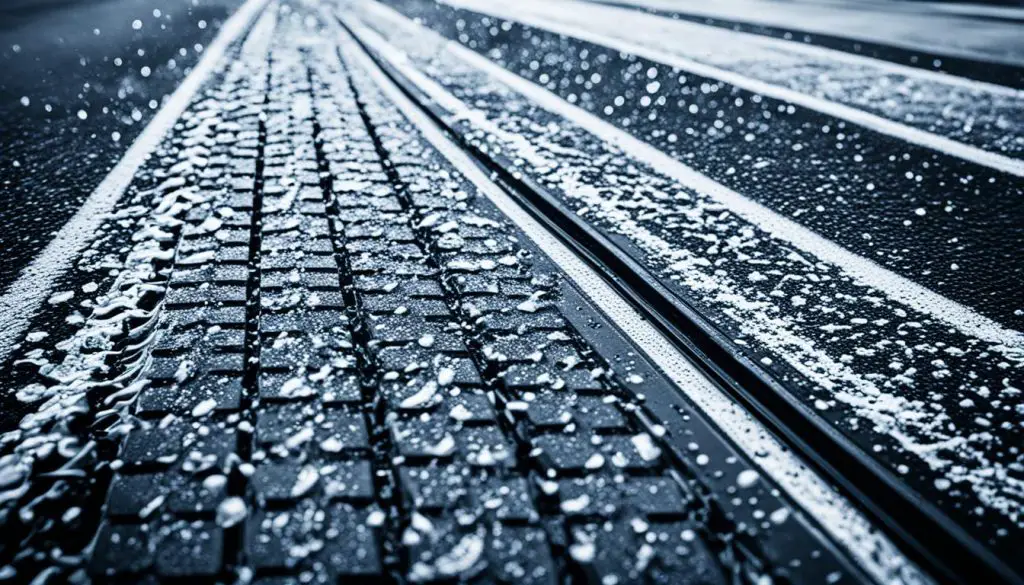
Tread Sipes
Tread sipes are tiny cuts in the tread that improve how well the tire gets a grip. They are very useful on slippery roads when it’s wet or icy. Winter tires have a lot of sipes to handle bad weather without slipping9. An irregular tread design with sipes is good for both dry and wet roads. It makes the drive safer in many situations11.
Knowing about tread blocks, grooves, and sipes can help you pick the right tires. With good understanding, you can choose tires that make your car work best and keep you safe.
The Role of Tire Tread Compound
Tire tread compound is crucial for tire performance. It affects many aspects, like traction and durability. The use of natural rubber in the compound helps resist tears and fatigue cracks, leading to longer tire life12. Synthetic rubbers such as butadiene and styrene increase rolling resistance, wear, and traction. These are vital for how well the tires perform12. Customers want tires that grip well, last long, and save fuel. So, the right tire tread compound is essential to satisfy these needs13.
Each tire type needs a specific compound. High-performance tires, for example, have low rolling resistance. This makes them use less fuel14. On the other hand, tires meant for all seasons or winter give strong wet grips for safety14. In making tires, silica lowers rolling resistance. Carbon black and a special silica type boost tear and abrasion resistance. This makes tires last longer12.
The composition of tire compounds is about 84% from chemical parts13. The average passenger tire might include 75 parts of SBR and 25 parts of BR13. Adding 15-30 of natural rubber makes the tire stronger and lasts longer13. By mixing these materials just right, the tires are not only durable but also perform well thanks to their advanced chemical composition13.
Notably, compounds behave differently in various test setups. They react unique to tests on rolling resistance, and wet or dry grip14. For instance, all-season and winter tires perform better in wet grip compared to high-performance tires. That’s why they are safer in winter14. Yet, high-performance tires have superior dry grip for fast driving14. Customizing compounds lets tire makers address specific driving needs and situations effectively.
How to Extend Tire Tread Longevity
Keeping your tires in great shape means looking after them well and driving smartly. Stick to specific steps, and you’ll see your tires last longer. This makes your car safer and more efficient.
Proper Tire Maintenance Tips
It’s key to keep your tire pressure right to help your treads last. They can lose air over time. This affects how your car performs and its safety. Plus, correctly inflated tires might make your gas last longer15. So, always check your tire pressure regularly.
Change where your tires are on the car every 5,000 miles to even out the wear. This step lengthens how long your tires can keep going15. It’s even better to do this alongside getting your wheels balanced. Balancing stops shakes and keeps the treads wearing right15. Also, twice a year, make sure your car’s wheels are straight. Straight wheels help tires last longer and use less gas15.
Keep an extra close eye on tire pressure as the seasons change. Top them up with air in the winter because the cold makes air in your tires shrink, which can be bad for your tires16. If you keep up this good habit and others like it, your tires will stay in good health longer.
Driving Habits to Preserve Tread Life
Good driving also makes tire treads last longer. Smooth starts and stops are kind to your tires. They avoid putting too much stress on them, which wears them out quickly16.
Take corners easy and skip sharp turns to help your treads. Watching out for bad road conditions, like potholes, is key. Bad roads can damage tire treads. And try not to hit curbs when parking; it’s not good for your tires either16.
To sum it up, take good care of your tires and drive thoughtfully. Doing these things together will boost how long your tires last. This keeps you safe while driving.
Risks of Reduced Tire Treads
Driving with worn-out tire treads is risky. It can lead to hydroplaning and poor traction on snow and ice. There’s also a higher chance of getting punctures. As treads wear down, the tires can’t channel water well or grip roads right.
Hydroplaning
Worn tire treads pose a major hydroplaning risk. If your tire treads are low, the tires can’t push water away. This makes steering and controlling the car hard. About 10% of cars on the road might have bald tires, making accidents more likely17. These accidents may result in serious injuries or even death17.

Reduced Traction on Snow and Ice
Tires with low treads are dangerous on snow and ice. They can’t grip well, affecting your safety. It’s harder to stop or steer, raising the danger. Tires perform poorly in winter when the treads are less than 4/32 of an inch18.
Increased Risk of Punctures
Worn tire treads are more likely to get punctures. Good treads help prevent punctures and blowouts. But if your tires are bald, they’re at a higher risk. Bald tires are also prone to going flat or blowing out, causing loss of control18.
Rotating tires every 6,000-8,000 miles keeps them in better shape. This practice improves tire life and safety17.
Understanding Tire Tread Indicators
Knowing when to get new tires is key for staying safe on the road. You should learn about tire tread indicators. They let you see if your tires are still in good shape. Treadwear bars and the UTQG rating system help you check this out.
Treadwear Indicator Bars
Treadwear indicator bars are small bars inside tire grooves. They help check how evenly the tread wears. When the tread gets even with these bars, it’s time for new tires619. This is because the tread has gotten too thin to be safe, mainly in bad weather6.
Some winter tires come with extra wear indicators for winter use. If these indicators are visible, the tires might not work well in the snow. In some places, they might even be illegal to use6. So, always check your tires in wet and snowy weather. Keeping your tire treads deep enough is important for safe stopping6.
Understanding UTQG Ratings
UTQG ratings tell you how long the tread of a tire can last. A higher UTQG number means the tire might last longer. But, remember to consider other things like warranties and real tire checks to get the full picture of how long your tires will last.
Using a tread depth gauge is also helpful. These tools can give you a specific measurement of your tire treads. Look for gauges with 1/16th inch markings. They show when the treads are too worn down and need to be replaced19. This careful approach helps you keep your tires working well and safe for longer.
“`html
| Tire Feature | Description |
|---|---|
| Treadwear Indicator Bars | Small raised bars within tire grooves that signal when tread depth reaches the minimum legal threshold (2/32 inches). |
| Winter Tire Wear Indicators | Additional indicators in winter tires that show when the tread is unsuitable for winter conditions. |
| UTQG Rating System | A system that predicts potential tread life relative to a reference tire, with higher numbers indicating longer tread life. |
| Tread Depth Gauge | Tool used for precise measurement of tread depth. Indicates when tread depth reaches dangerous levels requiring replacement (1/16 of an inch). |
What to Look For When Buying Used Tires
When buying used tires, it’s key to look at specific factors. This ensures your buy is safe and dependable. We’ll talk about the importance of checking the tire’s tread depth and looking for any damage.
Evaluating T tread Depth
First, let’s talk about tread depth. It’s crucial for safety and how well the tire works. A quality used tire must have 5-6/32″ of tread left. This gives it good grip and a long life20. Tires show wear through indicators at 6/32”, 4/32”, and 2/32”. This tells us their condition. Used tires usually have between 40% and 70% of their tread left. They provide great value by giving you miles for less money21. Be sure it meets or beats your area’s minimum tread depth. For example, in Canada, it can’t be less than 2/32″20.
Inspecting for Damage
Next, look for any damage. This includes cracks, cuts, or bulges. These might mean the tire could fail early and be dangerous22. Avoid tires with small cracks or dry rot signs. They’re more likely to fail soon. Tires with visible plug repairs aren’t a good choice. Plugs aren’t as effective as patches and might make the tire weaker20. Also, watch out for bald spots or steel belts poking out. These warn of a tire that wasn’t cared for22.
Take your time to check the tires over well. Looking for bulges, cuts, or any unusual wear is crucial. The way tires were stored or used can affect how well they perform. Remember, using them right matters too21.
In short, carefully checking the tread depth and looking for damage is crucial when you’re thinking about used tires. Inspecting them well makes sure they are safe and good to use. This avoids the need to replace them soon and any unseen dangers.
Conclusion
Understanding tire tread is key for road safety and top-notch performance. Knowing about tread wear signs like feathering or scalloped wear helps spot when to maintain your tires. This cuts the risk of accidents due to uneven wear, and boosts how well your car handles and grips the road23.
Checking and upkeeping tire tread depth stops problems like hydroplaning and loss of control, keeping you safe. Valuing tire health helps prevent accidents. Plus, it could mean cheaper insurance and discounts from safety-minded insurers23.
In the end, never ignore tire care. By grasping tire tread basics, keeping the right depth, and driving safely, you’ll extend tire life. This enhances your car’s performance and, most crucially, keeps you and others safe on the road. Keeping tires well-maintained supports safety and a budget-friendly, longer driving life.
FAQ
What is tire tread and why is it important?
Tire tread is the rubber on the tire’s outer edge that meets the road. It’s key for safety and performance, especially in the rain. Good treads stop your car from sliding on water. They do this by pushing water out, so the tire grips the road well.
How do I measure tire tread depth?
To measure tire tread, you can use a penny, a quarter, or a gauge. The penny test shows if you have at least 2/32 inch of tread left by hiding Lincoln’s head. The quarter test, hiding Washington’s head, checks for 4/32 inch.
A gauge gives the most accurate reading. These checks keep your tires safe and legal on the road.
What are the legal requirements for tread depth?
In the US, tires must have a minimum 2/32 inch tread depth. Treadwear bars let you know when your tires are too worn. To be safe and perform well, change tires at 4/32 inch, especially in the rain.
How does tread wear affect safety?
As treads wear, stopping takes longer, and handling on wet roads gets worse. Worn treads can’t push water aside, risking sliding and accidents. So, new treads are vital for your safety.
What causes tire tread wear?
Driving roughly, wrong tire pressure, and bad roads wear treads. Sticking to tire care can fight these enemies and keep tires lasting longer.
What are the different types of tire tread patterns?
Tires can have symmetrical, asymmetrical, or directional tread patterns. Each kind helps in different ways like noise reduction, water clearing, and handling. The best choice depends on the weather you drive in and your car’s needs.
What are tread blocks and why are they important?
Tread blocks touch the road for grip. They keep your car steady and enhance control. Good tread block design is about safe driving.
How do tread grooves and sipes function?
Grooves take water out to prevent slipping; sipes cut in the tread block grab the road on ice or rain. These features work together for safety in bad weather.
What is the role of tire tread compound?
The compound affects tire performance. Summer tires have more rubber for good grip; winter tires need special compounds to stay flexible on ice and snow.
How can I extend the life of my tire treads?
To make treads last, keep your tires cared for. This means checking them often, rotating them, and driving smoothly. This simple care adds miles to your tires.
What are the risks of reduced tire treads?
Treads that are too low mean your tires might slide on water or ice. With less tread, it’s hard for tires to push water away. This raises your chances of getting into an accident.
What are treadwear indicator bars?
Indicator bars show you when the tread is too worn, warning that the tire is dangerous. Their message is clear: time for a new tire to stay safe.
What is a UTQG rating and how does it help?
The UTQG number tells you how long a tire should last compared to others. A high number means longer use. Yet, it’s best used along with a warranty and regular checks to fully understand a tire’s life.
What should I look for when buying used tires?
When purchasing used tires, check for enough good tread and even wear. Look for damage too, like cuts: these signs ensure your safety.
Source Links
- https://www.utires.com/articles/what-is-tire-tread-depth-everything-you-need-to-know/
- https://en.wikipedia.org/wiki/Tire_tread
- https://www.belletire.com/tire-buying-guide/tread-patterns-components
- https://www.bridgestonetire.com/learn/maintenance/how-to-check-your-tire-tread-penny-test/
- https://jacosuperiorproducts.com/blogs/news/the-simple-guide-to-checking-your-tire-tread-depth-and-knowing-when-to-replace-your-tires
- https://www.continental-tires.com/products/b2c/tire-knowledge/tread-depth/
- https://www.bridgestonetire.com/learn/maintenance/tire-tread-wear-causes/
- https://www.consumerreports.org/cars/tires/truth-about-tire-treadwear-how-cr-tests-tread-life-a6218520265/
- https://www.tires-easy.com/blog/different-tread-patterns-on-tires/
- https://www.pepboys.com/tires/tire-care/tread-type
- https://www.bridgestonetire.com/learn/shop/tire-tread-patterns/
- https://www.ustires.org/whats-tire-0
- https://www.cewheelsinc.com/the-science-behind-tread-compounds-on-passenger-tires/
- https://www.engineering-group.com/a-study-of-dynamic-testing-methods-for-tire-tread-compounds/
- https://www.lesschwab.com/article/tires/how-to-make-your-tires-last-longer.html
- https://www.synchrony.com/blog/automotive/tire-life-how-to-keep-long-lasting-tires–mysynchrony.html
- https://www.utires.com/articles/can-low-tire-tread-cause-a-car-accident/
- https://www.bridgestonetire.com/learn/maintenance/bald-tires/
- https://www.tiresplus.com/blog/tires/what-are-wear-bars/
- https://www.kijijiautos.ca/advice/content/what-to-look-for-when-buying-used-tires/
- https://www.utires.com/articles/used-tires-goodbuy/
- https://www.wikihow.com/Choose-Used-Tires-for-a-Car
- https://www.insuranceagencynetwork.com/blog/understanding-tire-tread-wear-patterns
